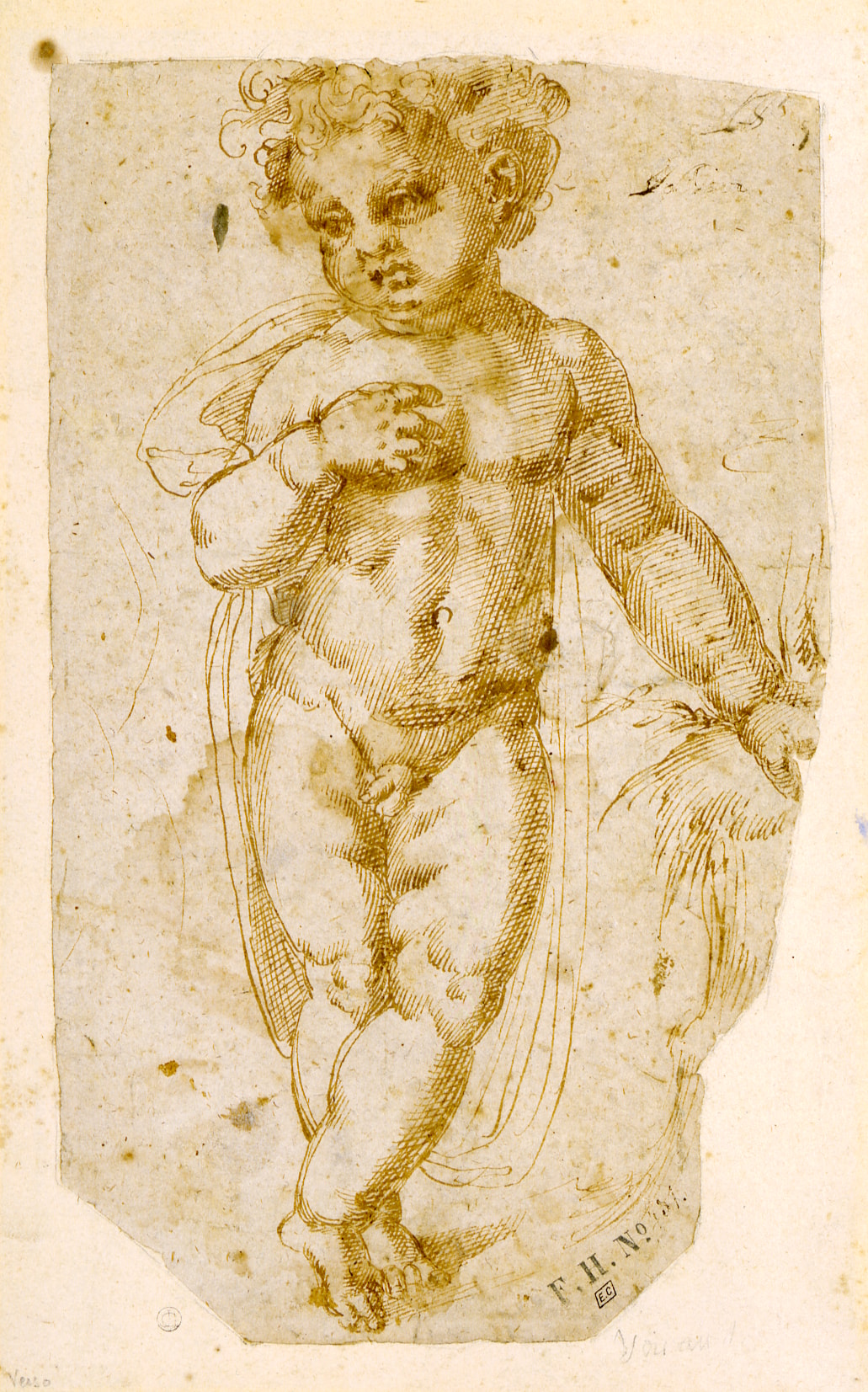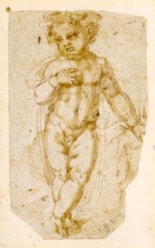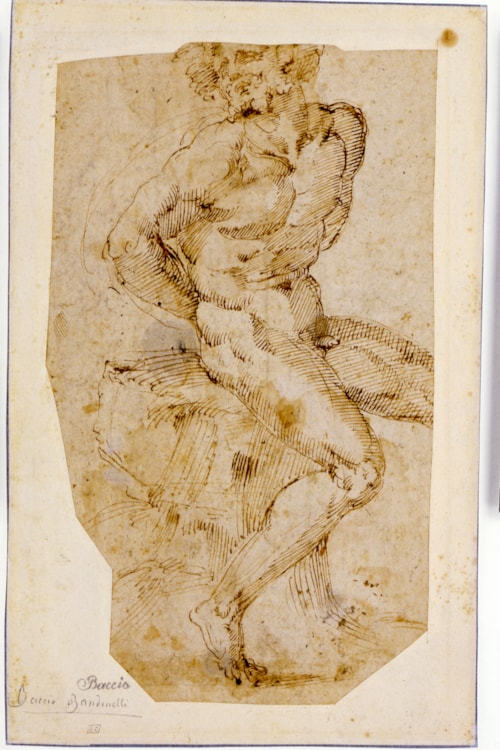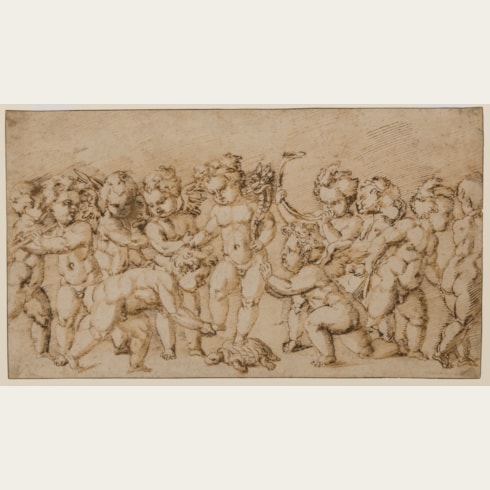Baccio BANDINELLI
(Florence 1493 - Florence 1560)
Study of a Standing Putto [recto]; A Male Nude Bound to a Rock [verso]
Sold
Pen and brown ink on buff paper, irregularly trimmed at the edges and inlaid on an old backing sheet.
Illegibly inscribed and numbered at the upper right.
Inscribed Baccio and Baccio Bandinelli on the verso of the backing sheet.
284 x 171 mm. (11 1/8 x 6 3/4 in.) at greatest dimensions.
Illegibly inscribed and numbered at the upper right.
Inscribed Baccio and Baccio Bandinelli on the verso of the backing sheet.
284 x 171 mm. (11 1/8 x 6 3/4 in.) at greatest dimensions.
Although somewhat larger in scale, the study of a chubby putto on the recto of this drawing can be likened to a number of drawings by Bandinelli of groups of standing infants, of which examples are in the Fondazione Horne in Florence and the Städelsches Kunstinstitut in Frankfurt; a third was on the art market in 1998 and is now in a private collection. Drawings such as these appear to have been inspired, if perhaps indirectly, by similar putti in the public sculpture of Bandinelli’s illustrious predecessor, Donatello. In particular, Bandinelli’s drawings of putti are similar to their counterparts in the frieze of putti at play running above the main scenes of Donatello’s bronze pulpit reliefs for the church of San Lorenzo in Florence, executed in the early 1460’s although not installed in the church until 1515.
The study of a bound prisoner on the verso of this sheet may be associated, as Roger Ward has suggested, with several drawings of captive male nudes by Bandinelli, which, in turn, have been related to a bronze relief of The Deposition presented by the sculptor to the Emperor Charles V in Genoa in 1529. Described by Vasari as an ‘opera rara, e’ la fece con gran diligenza gettare di bronzo’, Bandinelli’s relief is now lost, although its appearance survives in a gesso modello in the Museo di Stato in San Marino, as well as in a bronze relief copy by Antonio Susini - probably made from a wax cast of the original - in the Louvre. While none of these drawings of captive nudes by Bandinelli - including studies in the Uffizi, the British Museum, the Louvre, the Nasjonalgalleriet in Oslo and a private French collection - repeat precisely the pose of the crucified thieves in the bronze Deposition relief, all depict bound male figures posed in violent contrapposto. Each of these powerful drawings are, as Ward has described them, ‘executed in that bold and urgent style that is the quintessence of [Bandinelli’s] pen technique in preparatory designs.’
The present sheet once belonged to Jean-François Gigoux (1806-1894), a painter and lithographer who assembled a large and significant collection of paintings and drawings. Many of these were presented to the museum in his native town of Besançon, but others were dispersed in a series of auctions between 1861 and 1882. The drawing was acquired at the last of these sales by the collector Emile Calando (1840-1898), in whose family it remained until 1927. The drawing later entered the collection of Sir Kenneth Clark, later Lord Clark of Saltwood (1903-1983).
The study of a bound prisoner on the verso of this sheet may be associated, as Roger Ward has suggested, with several drawings of captive male nudes by Bandinelli, which, in turn, have been related to a bronze relief of The Deposition presented by the sculptor to the Emperor Charles V in Genoa in 1529. Described by Vasari as an ‘opera rara, e’ la fece con gran diligenza gettare di bronzo’, Bandinelli’s relief is now lost, although its appearance survives in a gesso modello in the Museo di Stato in San Marino, as well as in a bronze relief copy by Antonio Susini - probably made from a wax cast of the original - in the Louvre. While none of these drawings of captive nudes by Bandinelli - including studies in the Uffizi, the British Museum, the Louvre, the Nasjonalgalleriet in Oslo and a private French collection - repeat precisely the pose of the crucified thieves in the bronze Deposition relief, all depict bound male figures posed in violent contrapposto. Each of these powerful drawings are, as Ward has described them, ‘executed in that bold and urgent style that is the quintessence of [Bandinelli’s] pen technique in preparatory designs.’
The present sheet once belonged to Jean-François Gigoux (1806-1894), a painter and lithographer who assembled a large and significant collection of paintings and drawings. Many of these were presented to the museum in his native town of Besançon, but others were dispersed in a series of auctions between 1861 and 1882. The drawing was acquired at the last of these sales by the collector Emile Calando (1840-1898), in whose family it remained until 1927. The drawing later entered the collection of Sir Kenneth Clark, later Lord Clark of Saltwood (1903-1983).
One of the leading sculptors of the Cinquecento in Italy, Baccio Bandinelli was profoundly influenced by the work of Michelangelo, a lifelong rival whose fame he sought to emulate throughout his career. Although he received several important Roman commissions, he worked in Florence for much of his life, where he enjoyed the patronage of the Medici. There his major public sculptural commissions included a statue of Saint Peter for the facade of the Duomo, the Hercules and Cacus for the Piazza della Signoria and the monument to Giovanni delle Bande Nere outside the church of San Lorenzo. He also sculpted a figure of Orpheus for the courtyard of the Palazzo Medici, as well as sculptures for the Sala dei Cinquecento in the Palazzo Vecchio and the high altar of the Duomo. Bandinelli also worked occasionally as a painter, notably receiving a commission from Pope Clement VII for two frescoes for the Florentine church of San Lorenzo, though the project was eventually abandoned. In Rome, he designed and executed the tombs of the Medici popes Leo X and Clement VII. In 1546 he began work on an elaborate marble choir screen, ornamented by statues and reliefs, for the Duomo in Florence; an immense project that occupied him, on and off, for the remainder of his career. Like every sculptor of his age, however, Bandinelli remained in the lifelong shadow of Michelangelo, whose mastery of technique he was never quite able to equal.
Bandinelli’s contemporary fame was based as much on his drawings as on his sculpture, and Vasari notes of him that he was ‘allora disegnatore molto stimato’. He was a prolific draughtsman, and more studies by him survive than by any other 16th century sculptor save Michelangelo. (He is also known to have made drawn copies after the work of such earlier sculptors and painters as Giotto, Masaccio, Desiderio da Settignano, Donatello, Fra Bartolomeo and Leonardo, as well as Michelangelo.) Indeed, drawing was the foundation of Bandinelli’s art, as was noted in the Memoriale – long thought to be the artist’s autobiography but recently identified as having been composed by his grandson – where he is claimed to have stated that ‘All my concentration was fixed on drawings...it is above all in that activity that I have prevailed.’ Certainly, the artist valued his drawings highly, and he seems not to have parted with many of them, further insisting that his heirs retain them after his death; ‘the drawings, of which I leave behind almost a full cassone, should be guarded like so many jewels; do not let them slip through your fingers, for there will come a time when they will be regarded as treasures.’
That Bandinelli’s drawings continued to be admired by collectors long after the artist’s death is seen in Pierre-Jean Mariette’s comments in the 1741 sale catalogue of drawings from the Crozat collection; ‘Baccio's style of drawing is very skillful, as one would expect from a master who had a profound knowledge of the structure of the human body and all its movements; but this style is also overly austere, even savage... I prefer the drawings this master made in pen to those he executed in red chalk; they appear less resolute, but they are closer to the truth.’ Some five hundred drawings by Bandinelli are known today, the majority of which are in pen and ink, although some are in black or red chalk.
Bandinelli’s contemporary fame was based as much on his drawings as on his sculpture, and Vasari notes of him that he was ‘allora disegnatore molto stimato’. He was a prolific draughtsman, and more studies by him survive than by any other 16th century sculptor save Michelangelo. (He is also known to have made drawn copies after the work of such earlier sculptors and painters as Giotto, Masaccio, Desiderio da Settignano, Donatello, Fra Bartolomeo and Leonardo, as well as Michelangelo.) Indeed, drawing was the foundation of Bandinelli’s art, as was noted in the Memoriale – long thought to be the artist’s autobiography but recently identified as having been composed by his grandson – where he is claimed to have stated that ‘All my concentration was fixed on drawings...it is above all in that activity that I have prevailed.’ Certainly, the artist valued his drawings highly, and he seems not to have parted with many of them, further insisting that his heirs retain them after his death; ‘the drawings, of which I leave behind almost a full cassone, should be guarded like so many jewels; do not let them slip through your fingers, for there will come a time when they will be regarded as treasures.’
That Bandinelli’s drawings continued to be admired by collectors long after the artist’s death is seen in Pierre-Jean Mariette’s comments in the 1741 sale catalogue of drawings from the Crozat collection; ‘Baccio's style of drawing is very skillful, as one would expect from a master who had a profound knowledge of the structure of the human body and all its movements; but this style is also overly austere, even savage... I prefer the drawings this master made in pen to those he executed in red chalk; they appear less resolute, but they are closer to the truth.’ Some five hundred drawings by Bandinelli are known today, the majority of which are in pen and ink, although some are in black or red chalk.
Provenance
M. de Bourguignon de Fabregoules, Aix-en-Provence, until c.1840
Charles-Joseph-Barthélemi Giraud, Aix-en-Provence and Paris
Flury-Hérard collection, Paris (Lugt 1015), with associated number 481
Flury-Hérard sale, Paris, Hôtel des Commissaires-Priseurs, 13-15 May 1861, part of lot 11 (‘Étude d’enfant à la plume et au bistre.’), bt. Gigoux with another drawing for 3 francs
Jean-François Gigoux, Paris and Besançon (Lugt 1164), his mark on the backing sheet
His sale, Paris, Hôtel Drouot, 20-23 March 1882, lot 7 (‘Bandinelli (Baccio): Enfant nu et en pied. A la plume. Au verso: Milon de Crotone. A la plume.’)
Emile-Louis-Dominique Calando, Paris (Lugt 837)
His son, Emile-Pierre-Victor Calando, Paris and Grasse
His sale, Paris, Hôtel Drouot, 17-18 March 1927, lot 9
Sir Kenneth Clark, C.H., K.C.B., Saltwood Castle, Kent
His sale, London, Sotheby’s, 20 April 1967, lot 5
Charles E. Slatkin Galleries, New York, in 1967
Kovler Gallery, Chicago, in 1968.
Literature
Roger B. Ward, Baccio Bandinelli as a Draughtsman, unpublished Ph.D thesis, Courtauld Institute of Art, University of London, 1982, pp.299-300, no.212.






